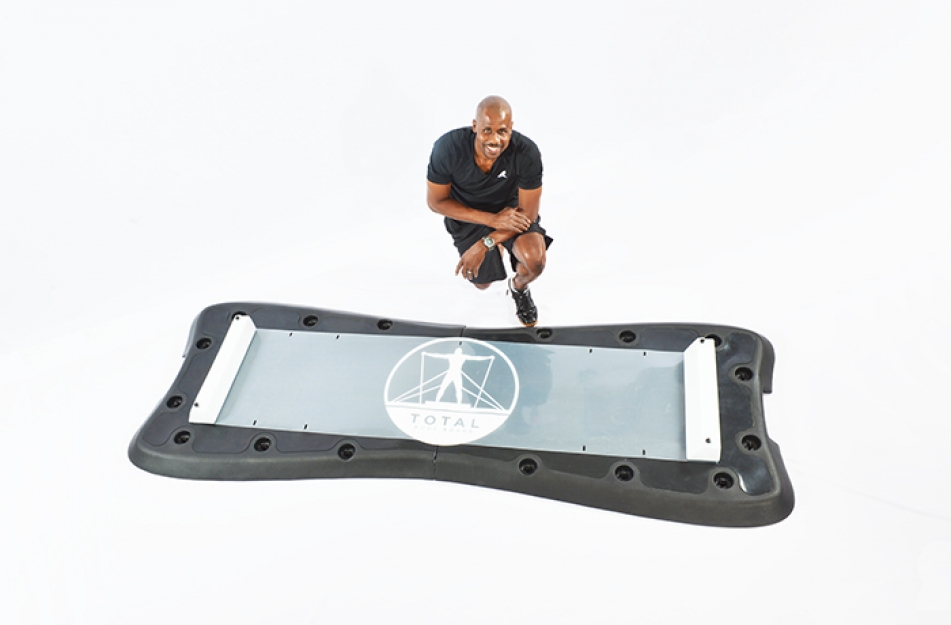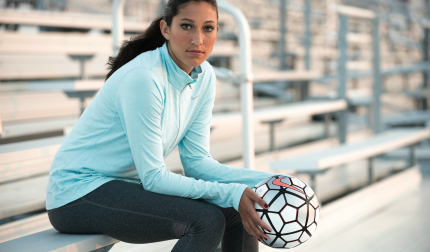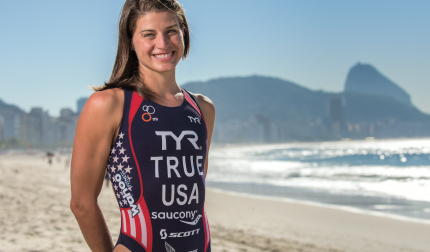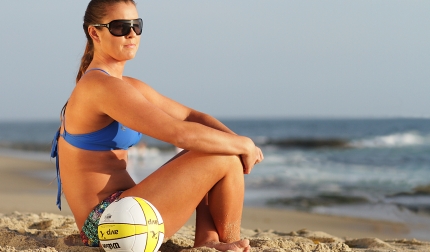How did you get your start in high jumping?
Honestly, in my senior year of high school, it was a way for me to hang out with my friends. They talked me into doing it. I hadn’t jumped since my seventh and eighth grade years. My friends wanted me to hang out with them on the track team while we were getting ready to graduate. I asked the coach if I could do it, and he said no (laughs). One of my friends and teammates, Robert Blackmon, he went on to play in the NFL for the Seattle Seahawks, went in and talked to the coach and convinced him to let me jump. I jumped 6’11” that year. Went to Texas State, (It was called Southwest Texas then.), and came in second in the NCAA Championships in my junior year. Won in my senior year. In my first year out of college, I won my first World Championship and set the current American record.
You also suffered a very serious knee injury during that time.
I tore my patella tendon during my senior year of college, but I continue to jump on it anyway, during 1990, ’91, ‘92, and the first half of 1993. Finally, I had to have surgery. It was completely shredded. Four different doctors, two in Europe and two in the United States, told me I would never jump at an elite level again. So I had the surgery and began my own rehab program. I was always my own coach anyway. In 1996, I won the gold medal at the Olympics.
Had anyone ever come back from that type of injury before?
I don’t know if anyone had done it at that level. To me, it wasn’t rocket science. I listened to my body and paid attention to it. I was always really into efficiency, knowing when my body felt at its best. Once I committed to being the best I could be, I just studied and learned just like you would anything else.
Did you ever doubt yourself?
Never! I liked the challenge. It was time to get to know myself and what my real potential could be. It was on me to make it happen. The payoff was that it also allowed me to discover the ability to focus at a high level. The doctor who did my surgery, he said there was no way I would be able to tolerate the force and stress at that level of jumping. We laugh about it now. I enjoyed the challenge. If you give me a 1% chance of making something happen, I’m always going to bet on myself.
Once you reach the pinnacle of competition again, did people start to seek you out?
Sure. To this day, because I trained myself, no one knows how I trained. Some of my competitors came out to train with me, but the workouts were a little too tough for them (laughs). It was all right there for me. I would watch video of the best athletes in the world and I would try what they did. I would be at these meets with the best athletes in the world, and I would talk to them. There was all of this knowledge right in front of me. I wasn’t shy to ask someone, “Explain this exercise to me. It looks interesting.” People would offer the information. I would apply it to what I was doing. If it worked, I stayed with it. If it didn’t work right away, I’d store it away in my head, and when I felt my body was ready, I would try it again. Most people would have paid a lot of money to have that kind of information.
But now you train a lot of different people not just in performance, but in fitness as well.
Yes, I started my sports performance and fitness training business in 2001. John Starks was my first client. I was still competing at the time. I competed in the world championships that year. Once we talked, he said he wanted me to train him. I was figuring out what my transition was going to be from being an athlete to the next phase of my life. I had started competing in 1990, and I was getting burned out. Physically, I could still compete, but mentally I was done. I had ridden that horse long enough. Once I started with John, I applied some of my training to him. He had great results and enjoyed it. I also started working with David Robinson. I opened up a studio shortly thereafter. Now I work with everyone from pro athletes to kids to people who want to get into better shape.
What was the inspiration behind inventing the Total Body Board?
I’m always looking for ways to improve my training. One night, I took some magazines home, and looked at the fitness equipment in them. I wanted to see what was the latest and best thing out there. But it all seemed the same to me. At 2 a.m., I woke up with the concept. I had everything in my head. I tried to blow it off, but I couldn’t go back to sleep. So I typed everything into my iPhone, all my thoughts. After that, I fell right asleep. The next day, in between working with clients, I would run to Lowe's and buy particleboards. Then I’d run back to get clamps and bungee cords. By 3 p.m., I had something functional. I still have it to this day. There were some baseball players that came into the studio during that time and they would use it. I used it for a while, just to make sure I wasn’t crazy. Then I drew another sketch and took it to a woodcrafter to have it built to my specs. I used that one for a year and a half. No one even knew about it, unless they were in my performance center. Finally, I hired a designer to get the picture in my head out. We got it exactly how I wanted it to look and feel. We launched it at the IDEA World Fitness Convention this year, and we’ve already received great feedback from it.
Lots of people have ideas but never get them to the marketplace. What was the toughest obstacle in getting that idea from your mind to a final product?
Truthfully, dealing with other people (laughs). Remember, I was my own coach. I like to be in control, because I know the work I am willing to put in, and I’m going to grind to get it done. Now, I need a team to achieve the success I want to have. I want this part of my life to outdo my athletic career.
You’re a world champion and Olympic gold medalist. That’s saying a lot!
In my mind, my athletic career wasn’t so hard. After my sophomore year of college, I committed myself to it. It became my oxygen. It sounds a bit psychotic, but it’s who I was as a person. That’s what I’m feeling now with the Total Body Board. I want it to be better every day. I’ve come up with over 200 exercises for it. But I have to rely on my team to do their part. Manufactures have their part to do. I can’t expect that they are going to drop everything to make my boards. I have to wait my turn.
And you’re still competing! You just set a masters record in the high jump at age 47!
Well, I really just did that to promote the board (laughs). Someone mentioned that they were having a masters track meet at Texas State. I called the school and they asked if I would compete in it. I said, “Give me two or three weeks, maybe I’ll surprise everyone.” Well, then the people at the gym wanted me to jump. My family got in on it. I hadn’t jumped in over two years. My middle son graduated from high school as one of the top two jumpers in the country. So I would take a jump with him now and then. I figured I would train for two weeks and see how I felt. When I heard the record for 45-50 year olds was 6’8”, I said no problem. That day, I did, 6’3”, 6’5” and 6’8 ¾” and called it a day. But I’m not actively competing.
That’s amazing! How have you managed to keep such a high skill level for so long?
I trained really hard for a long time, from 1987 until 2004 at a high level in a track and field setting. I did it right. No shortcuts. No supplements. Your body will remember all of that. If you keep yourself in decent shape, you’re never far off from being able to do things. I may not be able to do 7’10”. But if I train, I can still do 7’0” with no problem. I worked too hard over the years to let it go to waste.
To learn more about Charles Austin’s Total Body Board, visit totalbodyboard.com. For information on how to train with Charles, go to sohighsports.com.







